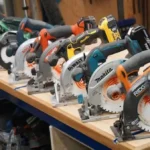If you are a DIY enthusiast, you might have wondered if you can use a Dremel instead of a drill for your projects. A Dremel is a brand name of a rotary tool that can perform various tasks such as cutting, sanding, grinding, polishing, and engraving. A drill is a power tool that can create holes and drive screws into different materials. Both tools are useful and versatile, but they have different purposes and features. In this article, we will compare Dremel vs. drill and help you decide which tool is best for your needs.
The short answer is: it depends on the task. A Dremel can be used for some drilling and screwing tasks, but it is not as powerful or efficient as a drill. A drill can be used for some cutting and sanding tasks, but it is not as fast or precise as a Dremel.
Dremel vs. Drill: What are the differences?
There are several differences between Dremels and drills that affect their performance and suitability for different tasks. Here are some of the main differences:
- Size and weight. One of the main differences between these two tools is that your average power drill is going to be much larger and heavier than your average Dremel rotary tool. Your average power drill, and 9.6 Volt drill, are going to weigh somewhere around 3.5 pounds. A Dremel, on the other hand, weighs only about 1.2 pounds. This makes Dremels easier to handle and maneuver, especially in tight spaces and for delicate work. Drills, however, are more stable and comfortable for longer and heavier tasks.
- Speed and torque. Another major difference between these two tools is their speed and torque. Speed refers to how fast the tool spins, measured in rotations per minute (RPM). Torque refers to how much force the tool can apply, measured in inch-pounds (in-lbs). Dremels have a much higher speed than drills, up to 35,000 RPM, compared to about 1,500 RPM for a top-end drill. This makes Dremels ideal for high-speed applications such as sanding, grinding, polishing, and cutting. Drills, however, have much more torque than Dremels, up to 600 in-lbs, compared to about 5 in-lbs for a Dremel2. This makes drills more powerful and effective for drilling holes and driving screws into hard materials.
- Bits and accessories. Another difference between these two tools is the variety and availability of bits and accessories. Dremels can use hundreds of different bits and attachments for various purposes, such as cutting, sanding, grinding, polishing, engraving, routing, and more. Drills, on the other hand, are mainly limited to drill bits and driver bits, although they can also use some other accessories such as hole saws, spade bits, and countersink bits. Dremel bits are usually smaller and more specialized than drill bits, and they can be changed quickly and easily with a collet system. Drill bits are usually larger and more general than Dremel bits, and they can be changed with a keyless or keyed chuck.
Dremel vs. Drill: Which tool should you use?
The answer to this question depends on the type and scope of your project. Here are some general guidelines to help you choose the right tool for the job:
- Use a Dremel if you need to:
- Cut or shape small or thin materials, such as wood, plastic, metal, ceramic, or glass.
- Sand or polish smooth or curved surfaces, such as wood, plastic, metal, ceramic, or glass.
- Grind or sharpen metal tools, such as knives, scissors, or blades.
- Engrave or etch designs or patterns on various materials, such as wood, plastic, metal, ceramic, or glass.
- Rout or carve grooves or channels on wood or other materials.
- Perform delicate or intricate work that requires precision and speed.
- Use a drill if you need to:
- Drill holes in large or thick materials, such as wood, plastic, metal, masonry, or concrete.
- Drive screws or fasteners into hard or dense materials, such as wood, plastic, metal, masonry, or concrete.
- Create large or deep cuts or holes, such as with a hole saw or a spade bit.
- Perform heavy-duty or long-lasting tasks that require power and stability.
Conclusion
Dremels and drills are both useful and versatile tools, but they have different purposes and features. A Dremel is a rotary tool that can perform various high-speed tasks, such as cutting, sanding, grinding, polishing, and engraving. A drill is a power tool that can create holes and drive screws into different materials. Both tools have their advantages and disadvantages, and the best tool for your project depends on the task and the material. We hope this article has helped you understand the differences between Dremel vs. drill and how to choose the right tool for your needs.



